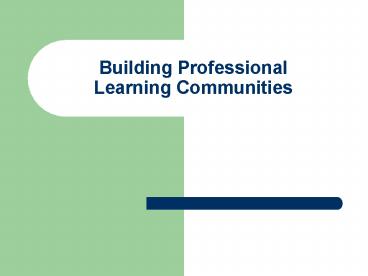Building Professional Learning Communities - PowerPoint PPT Presentation
1 / 17
Title:
Building Professional Learning Communities
Description:
Building Professional Learning Communities What is a Professional Learning Community? Ongoing teams that meet on a regular basis to learn, plan lessons, and solve ... – PowerPoint PPT presentation
Number of Views:197
Avg rating:3.0/5.0
Title: Building Professional Learning Communities
1
Building Professional Learning Communities
2
What is a Professional Learning Community?
- Ongoing teams that meet on a regular basis to
learn, plan lessons, and solve problems.
3
Mission
- Commitment to continuous improvement in daily
work to advance student achievement.
4
- Learning Communities may be various sizes and
serve different purposes based on areas of need
and interest.
5
- A Learning Community is a practical way to
improve teaching and learning.
6
- Teachers assist each other in examining student
standards, planning lessons, critiquing student
work and solving problems of teaching.
7
- Identify needs and ways to meet those needs by
- Acquiring necessary skills or behaviors
- Observing each other in classroom settings
- Sharing job related strengths
8
- Professional learning communities can be a
powerful staff development approach and a potent
strategy for school change and improvement.
9
Attributes of Learning Communities Five
Dimensions
- Supportive and Shared Leadership.
- Shared Values and Vision.
- Collective Learning and Application of Learning
(Collective Creativity). - Supportive Conditions.
- Physical conditions and human capacities that
support such an operation.
10
Procedures for Developing Learning Communities
- Collaboration embedded into daily work
- purposeful
- structured
- facilitated
- accountability
- Training in collaboration
- Collective work-shared lessons, student work
11
Procedures for Developing Learning Communities,
continued
- Protecting shared values
- Celebrating progress-individual and collective
- Reflective dialogue
12
Procedures for Developing Learning Communities,
continued
- Curricular focus-
- collaborative adoption process
- research-based, use of data assessment
model - commitment to continuous improvement
- Role of leadership-
- be fixated on results,
- focus on learning rather than teaching,
- shared decision making
13
First Steps
- Determine need
- Identify facilitator
- Set scheduled meeting times and dates
- Identify barriers and boosters
- Assign Learning Community roles
- Establish ground rules for Community
14
Results of Professional Learning Communities in
Action for Teachers
- Reduction of teacher isolation
- Increased commitment to the mission and goals of
the school - Shared responsibility for the total development
of students and their success - Creation of new knowledge and beliefs about
teaching and learners - Higher likelihood that teachers will be well
informed, professionally renewed, and inspired to
inspire students - More satisfaction, higher morale, and lower rates
of absenteeism
15
Results of Professional Learning Communities for
Students
- Decreased dropout rate and fewer classes
skipped - Lower rates of absenteeism
- Greater academic gains in math, science, history,
and reading than in traditional schools - Smaller achievement gaps between students from
different backgrounds
16
- Communication is key.
17
Resources
- DuFour,R. Eaker, R. (1998). Professional
Learning Communities at Work. National
Educational Service. - http//www.teachinflorida.com/teachertoolkit/PLC.h
tm - http//www.nsdc.org/standards/learningcommunities.
cfm































